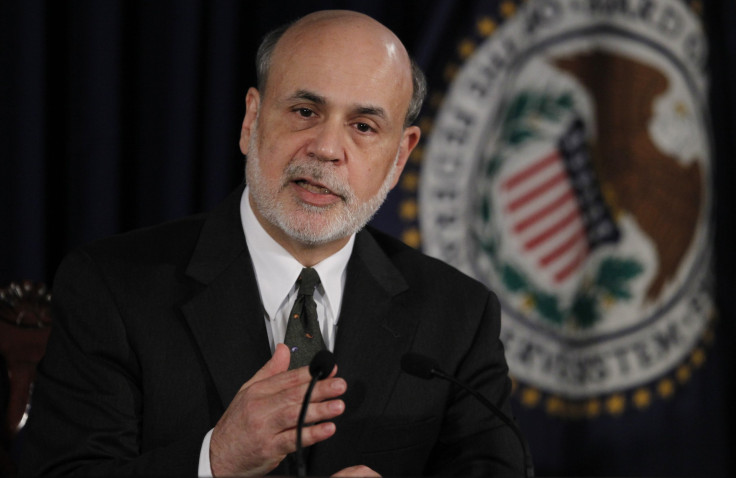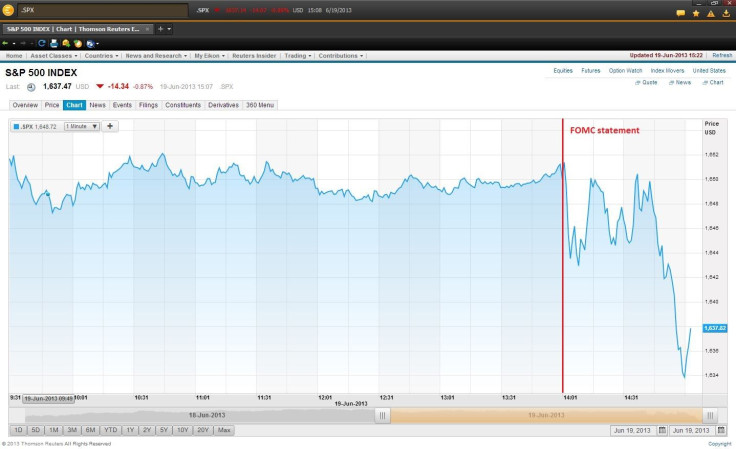Fed Chairman Ben Bernanke Press Conference, FOMC Decision: Live Blog [VIDEO]

Hello and welcome to our live coverage of the Federal Reserve's interest rate decision and the press conference that Ben Bernanke, the Fed's chief, will give a bit later in Washington, D.C.
The Federal Reserve's powerful rate-setting committee concludes its fourth meeting of the year today. The official statement -- along with the updated survey of economic projections from FOMC participants -- will come out at 2 p.m. EDT Wednesday, followed by Bernanke’s press conference at 2:30. The news conference will be broadcast live on the Federal Reserve's UStream channel.
The questions on everyone’s mind right now: When exactly will the Fed start tapering its asset purchasing? Will the Fed chief definitely be leaving his post when his term expires at the end of January?
CLICK HERE To Refresh This Page For LIVE Updates.
****
Update 3:50 p.m.: And that’s a wrap. Thanks for tuning in. Bernanke's next post-FOMC press conference will take place on Sept. 18.
The biggest headline from this news conference was Bernanke’s announcement that the Fed could begin to reduce its bond-buying program later this year (if the economy continues to improve) and could end its purchases in the middle of 2014.
Update 3:42 p.m.: Reactions from Societe Generale's Aneta Markowska:
"We maintain our call for a September tapering. Prior to today’s meeting, we had assumed that asset purchases would come to a full stop by the January meeting.
"While Bernanke’s guidance suggested that buying will continue until mid-2014, our own forecast trajectory hits the 7 percent level of unemployment a bit earlier, before the end of Q1.
"We therefore still see the risks skewed toward a shorter tapering cycle than consensus currently assumes. After that, there is likely to be a long pause in Fed policy."
Update 3:35 p.m.: Reactions from Dean Maki, chief U.S. economist at Barclays:
“Our perception of the Fed’s criteria for tapering has changed. Even though we continue to be less optimistic than the FOMC on growth (which we thought would delay Fed tapering into early 2014), we continue to expect a faster decline in the unemployment rate, based on our view that the labor force participation rate will not rise significantly.
"Based on the chairman’s comments and our unemployment rate forecast, we now expect a reduction in the pace of asset purchases to $70 billion per month at the September meeting ($35 billion in Treasuries and $35 billion in agency MBS).
"Based on our outlook for the unemployment rate to fall to 7.0 percent in Q1 14, we expect asset purchases to be concluded by March 2014, a bit earlier than the mid-2014 expectation the chairman indicated in the press conference.”
Update 3:30 p.m.: Reactions from IHS Global Insight U.S. Economist Paul Edelstein:
"The Fed sent more tapering signals than we anticipated for this meeting. But we maintain that the Fed is too optimistic on unemployment, and continue to believe that it won’t taper until 2014. ... Markets shouldn’t worry about the Fed tapering this year, that is, if they believe Bernanke’s contention that the decision is truly data-dependent."
Update 3:12 p.m.: The markets are selling off on the fear that a more optimistic Fed economic outlook may push the central bank to pare back its bond buying sooner than expected. The Dow is down 149 points, or 0.98 percent, while the broader S&P 500 is off 0.96 percent.

Update 3:04 p.m.: Fox Business’ Peter Barnes gives the “Bernanke’s future plan question” another try. Sorry, but the Fed chairman is not taking the bait.
Peter Barnes: One of the highlights of the conference in Jackson Hole every year are the remarks by the Chairman, you. You are not going this year. We've heard it's because you have a conflict in your personal schedule, but some have taken that as a sign that you may not be staying on the job for another term. Could you comment on that? And could you offer us -- give us a little more explanation as to why you're not going to be in Jackson Hole for the first time?
Bernanke: As I said, I'm not going to comment on my personal plans.
Well, better luck next meeting.
Update 2:57 p.m.: Bernanke just made a very important point: The Fed’s target is not 7 percent, it's not 6.5 percent -- it’s maximum employment.
And according to their projections, most people on the committee think maximum employment means somewhere between 5 percent and 6 percent unemployment.
“That's where we are trying to get to,” Bernanke says.
Update 2:50 p.m.: Here comes the widely anticipated retirement question. And the Fed chief ducked it again …
Washington Post reporter Elan Wu: President Obama stated in an interview he believed you stayed in your position as chairman maybe longer than you wanted to and maybe longer than you were supposed to. Do you agree with that assessment of your term, and can you update us on any conversations you've had with him about your future?
Bernanke: Well, Elan, we just spent two days working on monetary policy decisions, and I would like to keep the debate, discussions here on monetary policy. I don't have anything for you on my personal plans.
Update 2:41 p.m.: Bernanke says the Fed could begin to taper its asset purchases later this year, if its forecasts for inflation and unemployment are correct.
Update 2:40 p.m.: Bernanke emphasizes that the 6.5 percent level in the unemployment rate is a threshold, not a trigger, for the first rate hike.
"For example, assuming that inflation is near our objective at that time, as expected, a decline in the unemployment rate to 6.5 percent would not lead automatically to an increase in the federal funds rate target but, rather, would indicate only that it was appropriate for the committee to consider whether the broader economic outlook justified such an increase."
Update 2:34 p.m.: Bernanke, in his introductory comments, focuses on the Fed’s strategy for normalizing policy in the long run.
Bernanke said: In the minutes of its June 2011 meeting, the committee set forth principles that it intended to follow when the time came to normalize policy and the size and the structure of the Fed's balance sheet.
However, one difference is worth mentioning.
While participants continue to think that in the long run the Fed’s portfolio should consist predominantly of Treasury securities, “a strong majority” now expects that the committee will not sell agency mortgage-backed securities during the process of normalizing monetary policy.
Update 2:28 p.m.: Bernanke is on in less than 2.
Update 2:25 p.m.: There was an unusual voting split, 10-2, with one hawkish dissent (looking for the Fed to pull back sooner) and one dovish (wanting more easing).
Esther George of the Kansas City Fed voted against because she was concerned about future economic imbalances. James Bullard of the St. Louis Fed dissented because he wanted to “signal more strongly its willingness to defend its inflation goal.”
Update 2:12 p.m.: Quick update on the markets. U.S. stocks initially turned positive and then fell to session lows as traders digested the news. The S&P 500 is down 9 points. Treasury prices and gold futures fell.
Update 2:00 p.m.: The Fed statement arrives.
As expected, no change in policy. The Federal Reserve said it will continue buying assets at a clip of $85 billion a month and hold short-term interest rates at essentially 0 percent until the unemployment rate falls to 6.5 percent.
In a more optimistic statement, the central bank said it is prepared to increase or reduce its purchases based on economic conditions. However, downside risks to the economy and the U.S. jobs market have "diminished since the fall."
Read the full text here.
The Fed has also released updated economic projections. Policymakers now expect growth to pick up in 2014 after slowing somewhat in 2013, with the unemployment rate falling to as low as 6.5 percent by next year instead of 2015 as previously forecast.
For the full breakdown, see here.
Update 1:52 p.m.: At the March press conference, Bernanke successfully ducked the question about whether he has any interest in another term. Will he make his retirement announcement today?
He will surely be asked about it again -- and perhaps this time he’ll answer.
Bernanke has been chairman of the Federal Reserve since 2006, and President Barack Obama seems to be ready to pick a new chief for the central bank.
In an interview aired this week, Obama said that Bernanke has stayed at the Federal Reserve “a lot longer than he wanted or he was supposed to.” Hint from the president: Bernanke would be stepping down when his term ends in January 2014.
Update 1:46 p.m.: Defined benefit corporate pension funds, life insurers, banks and depository institutions and money market funds are among some of the potential winners when the Fed eventually tapers, according to UBS strategist Boris Rjavinski’s analysis of different types of U.S. investors. Potential losers include the U.S. Treasury Department. (Read more: Fed Tapering: Winners & Losers)
Updated 1:38 p.m.: While we wait for the offical statement, let's take a look at how the job market is doing.
To be honest, it's very difficult to discern any meaningful improvement in the labor market trend. Nonfarm payrolls grew by 175,000 jobs in May -- slightly below the average monthly job growth of 176,000 in the first five months of this year. For all of 2012, average monthly job growth was 183,000. That number was 175,000 in 2011. Not sure if you can see much improvement there. I can't.
Update 1:27 p.m.: Investors believe they heard the end of quantitative easing, or QE, when Bernanke indicated in May during his congressional testimony that the Federal Open Market Committee might scale back the pace of bond buying “in the next few [FOMC] meetings” if the economy improves.
But most Fed watchers expect the central bank to announce today that they will keep buying bonds at a monthly pace of $85 billion while keeping their options open to scale back the program later this year if the U.S. economy continues to improve. Policymakers might start reducing bond buying as early as September.
Of 49 economists who responded to a question about when the Fed would completely halt bond purchases, 42 said they expect this by mid-2014. The remaining seven economists expect the program to end in the second half of 2014 or the first half of 2015.
(Read more on what to expect from the Fed.)
© Copyright IBTimes 2024. All rights reserved.




















